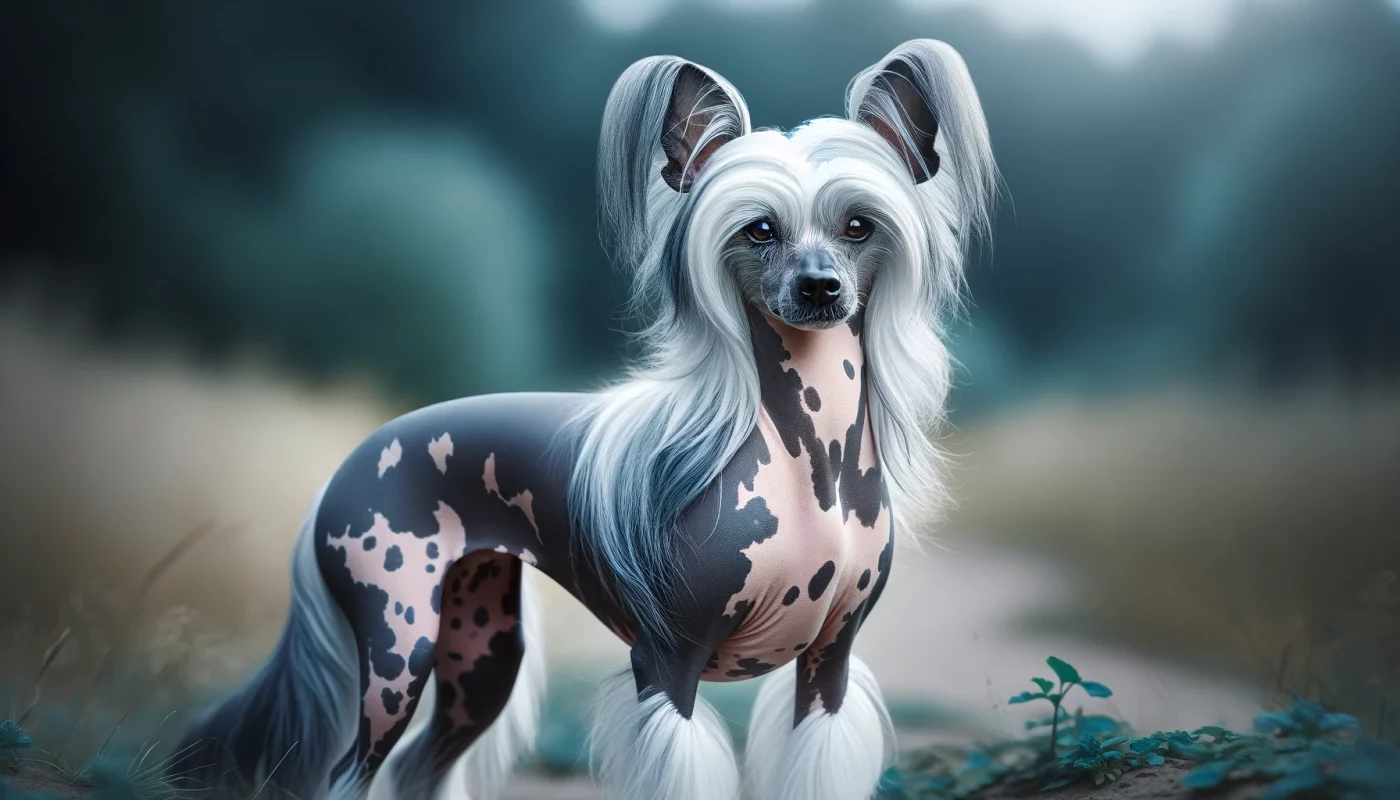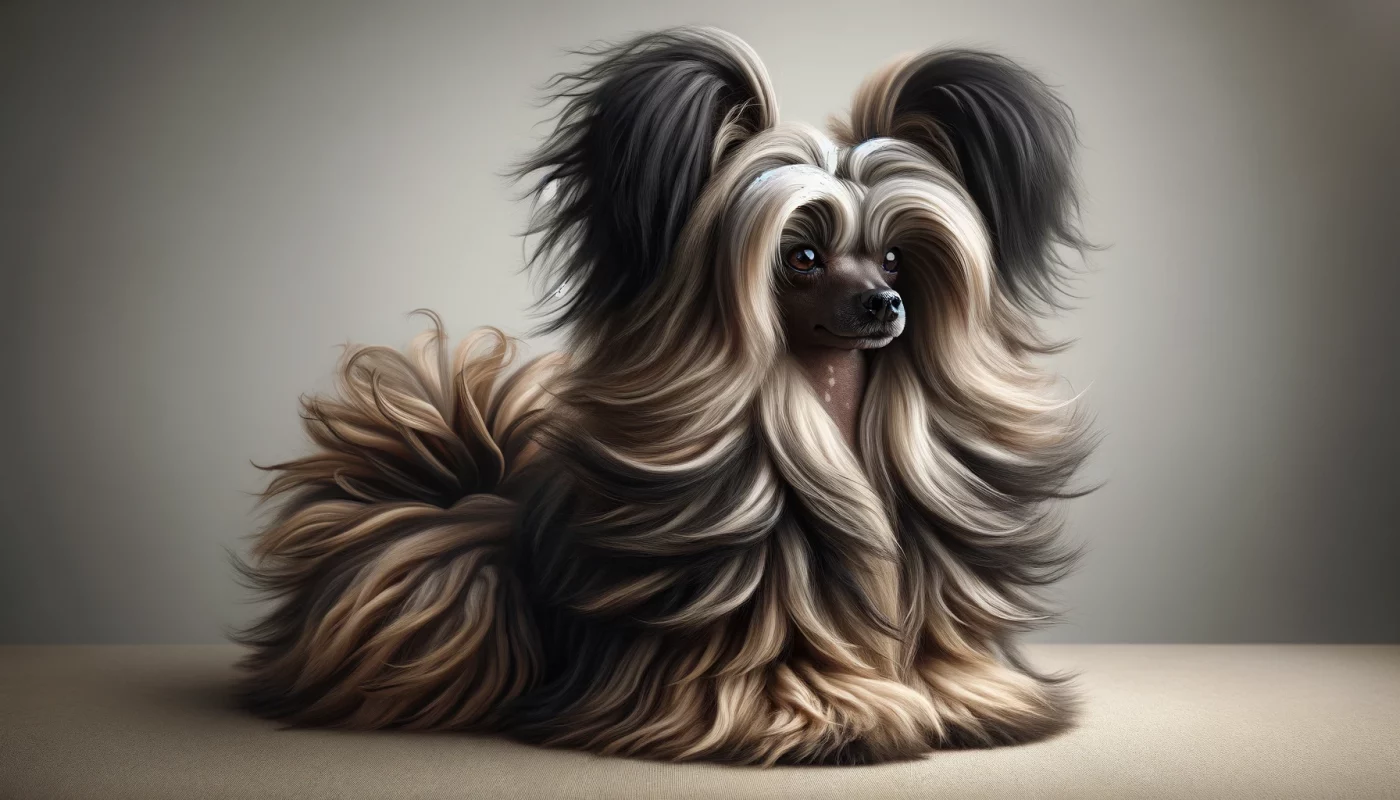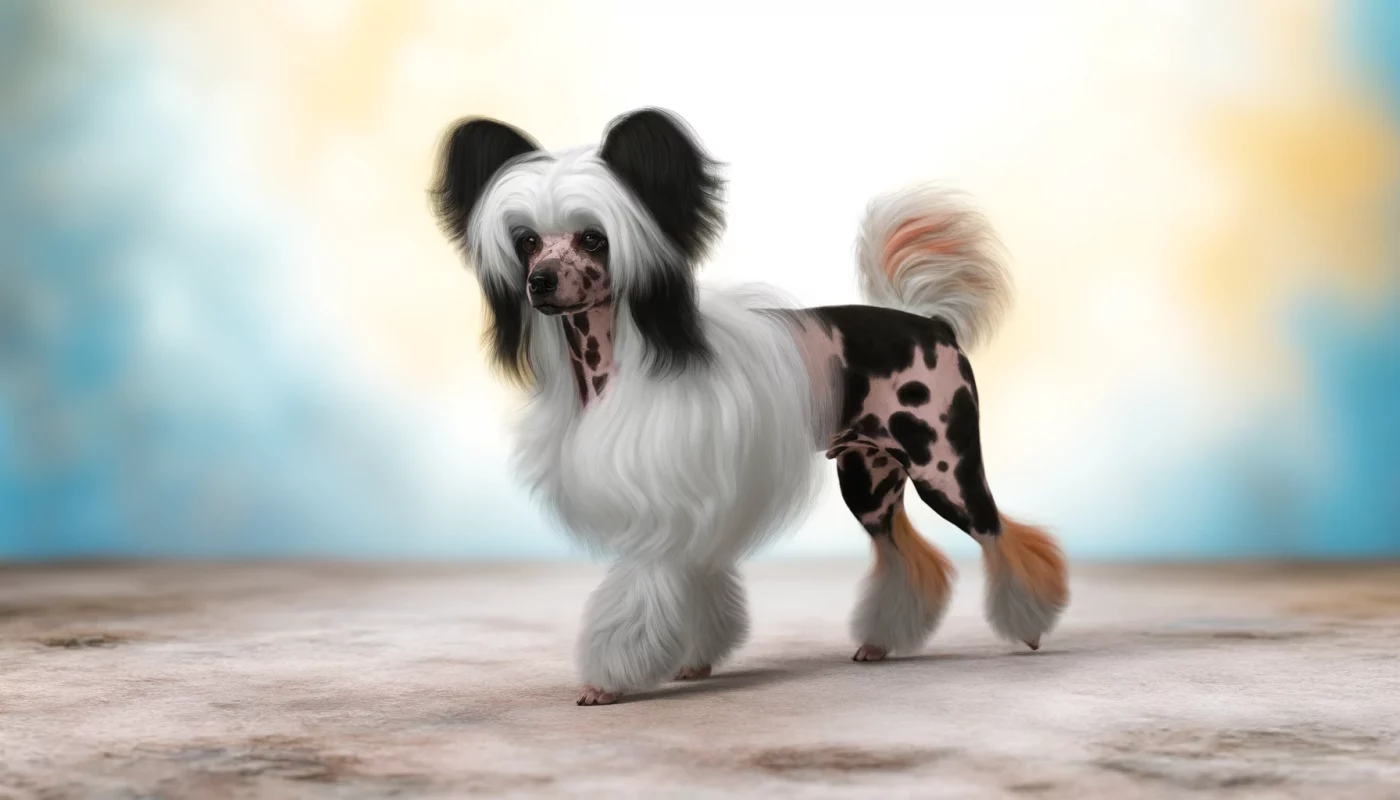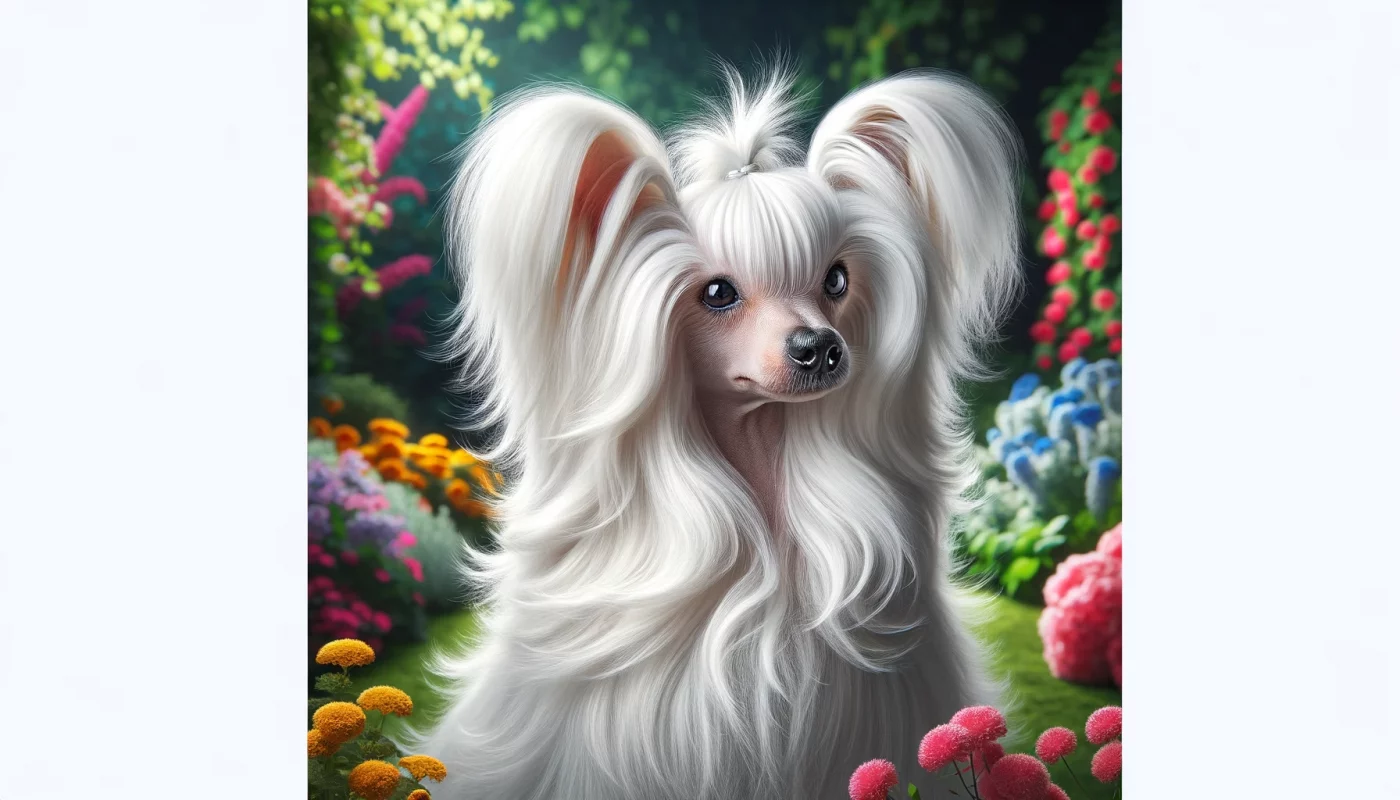Chinese Cresteds are one of the most distinctive dog breeds, celebrated not only for their unique physical attributes—ranging from fully hairless to the powderpuff, which sports a full coat—but also for their colorful skin and fur. These dogs bring a canvas of color variations that are both rare and captivating. This breed’s palette includes a mix of solid, spotted, and even metallic hues, making each individual dog uniquely stunning. This article delves into seven beautiful color variations of the Chinese Crested dog, exploring how each color contributes to the breed’s aesthetic and how it might influence grooming and care.
1. Hairless Pink and Chocolate

The Hairless Pink and Chocolate Chinese Crested stands out with its remarkable contrast between soft, light pink skin and deep, rich chocolate patches. This color variation exemplifies the breed’s exotic appeal, with the pink skin often appearing more vulnerable and requiring special care to protect against sunburn. Chocolate areas provide some natural protection against UV rays, making sunbathing somewhat safer in those patches. Owners cherish this color for its rarity and the dramatic beauty it lends to the breed, making it a frequent showstopper in competitions.
2. Hairless Slate and White

Hairless Chinese Cresteds with Slate and White coloring exhibit a sophisticated blend of cool slate-grey and crisp white patches. The slate grey provides a silvery sheen that is both unique and visually cooling, a perfect complement to the stark white that highlights the dog’s angular, elegant features. This color variation is not just visually striking but also practical, as the darker slate patches are less susceptible to sun damage compared to lighter colors. This coloration requires regular skincare to maintain the health and appearance of both pigmented and non-pigmented skin.
3. Powderpuff Sable

Sable Powderpuffs feature a mix of dark and light brown hairs, each with a black tip, creating a deep, multi-dimensional look that enhances the fluffy appearance of their coats. This variation is favored for its rich, warm tones that bring out the luxuriousness of the Powderpuff’s full coat. The interplay of dark and light within the sable pattern adds a level of complexity to grooming, as maintaining the luster and depth of color requires careful attention to bathing and conditioning.
4. Hairless Blue

In the Hairless Blue Chinese Crested, a blue coloration means a diluted black that gives the skin a striking blue-grey appearance. This metallic hue is especially popular for its futuristic look and the way it highlights the dog’s smooth, sculptural body lines. However, blue skin can be sensitive and prone to skin issues, requiring owners to invest in proper skincare routines, including the use of hypoallergenic products and regular moisturizing to prevent dryness and irritation.
5. Powderpuff Tricolor

Tricolor Powderpuffs are decked in black, white, and tan, arranging these colors in a striking pattern that often includes a predominantly white body with large black and tan patches. This tri-color scheme is visually appealing and quite rare, making each tricolor Powderpuff look distinct. The complexity of maintaining such a coat is higher than in single-colored dogs due to the need for frequent grooming to prevent matting and to keep the different colors bright and clear.
6. Hairless Black and White

The classic Hairless Black and White Chinese Crested is perhaps one of the most iconic looks in this breed. The sharp contrast between deep black and pure white areas accentuates the sleek, elegant lines of the hairless variety, while also making the minimal hair on the head, tail, and socks pop dramatically. This color pattern is beloved for its timeless elegance and the way it showcases the unique skin texture of the hairless variety.
7. Powderpuff White

A completely white Powderpuff Chinese Crested is a vision of fluffy purity. The all-white coat is rare and requires meticulous grooming to keep it clean and vibrant. White Powderpuffs are particularly prone to staining around the mouth and paws, necessitating regular washing and grooming. Nevertheless, their snowy appearance is highly prized for its striking beauty and the way it showcases the soft, flowing lines of the breed’s full coat.
The Chinese Crested dog is a spectacular display of nature’s artistry in canine form. Each color variation not only adds to the visual appeal of the breed but also brings with it specific care and grooming needs that owners should be prepared to meet. Whether showcasing the shimmering slate of a Hairless or the lush fluff of a Powderpuff, these colors make the Chinese Crested a beloved pet and a compelling show breed. Their diverse palette ensures that every owner can find a Chinese Crested that not only matches their aesthetic preferences but also captures their heart with its unique charm and personality.
Frequently Asked Questions About Chinese Cresteds Colors
1. What is the most common color for Chinese Cresteds?
The most common color for Chinese Cresteds is black and white. This striking combination is often seen in both Hairless and Powderpuff varieties. The contrast between the black and white is not only visually appealing but also accentuates the unique features of the breed, such as the soft, flowing hair on the head, tail, and paws of the Hairless, or the full coat of the Powderpuff. Black and white Chinese Cresteds are popular in the show ring due to their dramatic appearance and the way they showcase the breed’s distinctive hair patterns and skin quality.
2. Can Chinese Cresteds be a solid color?
Yes, Chinese Cresteds can be a solid color, although it is less common than patterned varieties. Solid-colored Chinese Cresteds can come in shades like black, chocolate, blue, or even pink in Hairless dogs where the skin tone appears as a consistent hue. Solid colors in Powderpuffs are typically white or cream. While solid colors might not have the dramatic visual impact of more patterned counterparts, they are equally recognized and cherished within the breed standards.
3. Are there any health concerns associated with certain colors in Chinese Cresteds?
In Chinese Cresteds, certain colors, particularly the blue and pink found in Hairless varieties, can be associated with specific health concerns. Blue Chinese Cresteds, which have a dilute black skin, are sometimes more prone to skin issues such as allergies and sensitivities. The pink skin of Hairless dogs, while not a color but a lack of pigmentation, can be susceptible to sunburn and requires protection against harsh sunlight. Prospective owners should be aware of these considerations and prepare to provide appropriate skincare and sun protection to maintain their dog’s health.
4. Do the colors of Chinese Cresteds change as they age?
Yes, the colors of Chinese Cresteds can change as they age. This is particularly noticeable in the Hairless variety, where the skin can darken or lighten depending on exposure to sunlight and other factors. Powderpuff Chinese Cresteds may also experience changes in their coat color, particularly if they start with a darker color like black or blue, which can fade over time due to sun exposure and aging. Regular grooming and care are important to maintain the coat’s appearance and health throughout the dog’s life.
5. What causes the ‘blue’ color in Chinese Cresteds?
The ‘blue’ color in Chinese Cresteds is caused by a dilution gene that affects the black pigment, resulting in a bluish or slate coloration of the skin and hair. This gene dilutes the black pigment to a grayish tone, which is why blue Chinese Cresteds often have a metallic sheen to their coat or skin. This color is relatively rare and sought after for its unique appearance, but it can be linked with certain skin conditions, as the same gene that causes color dilution can also affect skin health.
6. How does the merle pattern affect Chinese Cresteds?
The merle pattern in Chinese Cresteds results in mottled patches of color in the coat or skin and can affect both Hairless and Powderpuff varieties. Merle is caused by a specific gene that alters pigmentation, leading to a random dilution of color. This can create stunning patterns of dark and light areas. However, the merle gene can also bring health risks, particularly if two merle-patterned dogs are bred together, which can increase the likelihood of sensory deficits, including vision and hearing impairments.
7. What grooming needs are specific to different colored Chinese Cresteds?
The grooming needs of Chinese Cresteds vary slightly depending on their color, especially for the Hairless variety. Lighter colors and pink skin may require more frequent bathing to prevent staining and to maintain skin health. Sunscreen is necessary for Hairless dogs with lighter or pink skin when they are outdoors to prevent sunburn. Powderpuffs, regardless of color, require regular brushing to prevent tangles and matting in their dense coats. Additionally, dogs with lighter-colored coats may require more frequent grooming to keep their fur looking clean and bright.
8. Can Chinese Cresteds have different colored eyes?
Chinese Cresteds can have different colored eyes, especially those with the merle pattern. The merle gene can cause heterochromia, where one eye is colored differently from the other, or both eyes can have multiple colors. Eye color variations are more common in merle Chinese Cresteds but can occur in other colors as well. While this trait is visually intriguing, it does not typically affect the dog’s vision or overall health.
9. What is the rarest color found in Chinese Cresteds?
One of the rarest colors in Chinese Cresteds is true chocolate, which appears in both Hairless and Powderpuff varieties. This deep, rich brown color is less commonly seen than other colors and can be particularly striking. Chocolate Chinese Cresteds often have warm, amber eyes that complement their coat or skin color beautifully, making them stand out in both casual and show settings.
10. Are there any colors not recognized by kennel clubs in Chinese Cresteds?
While Chinese Cresteds come in a wide variety of colors and patterns, all are generally recognized by major kennel clubs like the AKC. There are no specific color restrictions for Chinese Cresteds; however, certain patterns such as albino (lacking any pigment) are not considered desirable due to associated health risks. Most color variations found in this breed are celebrated and add to the breed’s exotic allure, making them a favorite among dog enthusiasts for their unique and varied appearances.
 Toledo, United States.
Toledo, United States.